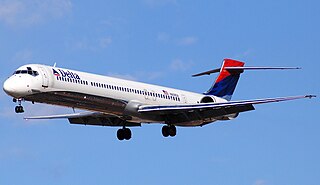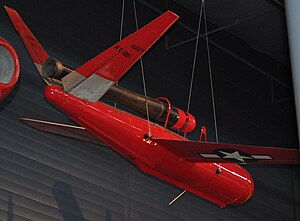
A pulsejet engine is a type of jet engine in which combustion occurs in pulses. A pulsejet engine can be made with few or no moving parts, and is capable of running statically.

The McDonnell Douglas DC-10 is an American wide-body airliner manufactured by McDonnell Douglas. The DC-10 was intended to succeed the DC-8 for long range flights. It first flew on August 29, 1970; and was introduced on August 5, 1971 by American Airlines.

The Boeing 717 is a twin-engine, single-aisle jet airliner, developed for the 100-seat market. The airliner was designed and originally marketed by McDonnell Douglas as the MD-95, a derivative of the DC-9 family. Capable of seating up to 134 passengers, the 717 has a design range of 2,060 nautical miles (3,820 km). It is powered by two Rolls-Royce BR715 turbofan engines mounted at the rear of the fuselage.

The McDonnell Douglas MD-90 is a single-aisle airliner developed by McDonnell Douglas from the MD-80, itself derived from the DC-9. After the more fuel-efficient IAE V2500 high-bypass turbofan was selected, Delta Air Lines became the launch customer on November 14, 1989. It first flew on February 22, 1993 and the first MD-90 was delivered to Delta in February 1995.

The McDonnell Douglas MD-80 is a series of single-aisle airliners developed by McDonnell Douglas from the earlier DC-9. Stretched, heavier, and with higher bypass Pratt & Whitney JT8D-200 engines, the DC-9 Series 80 was launched in October 1977. It made its first flight on October 18, 1979 and was certified on August 25, 1980. It was first delivered to launch customer Swissair on September 13, 1980, which introduced it into commercial service on October 10, 1980.

The McDonnell Douglas MD-11 is a wide-body airliner manufactured by American McDonnell Douglas (MDD) and later by Boeing. Following DC-10 development studies, the program was launched on December 30, 1986. Assembly of the first prototype began on March 9, 1988, it rolled out in September 1989 and made its maiden flight on January 10, 1990. FAA certification was achieved on November 8, the first delivery was to Finnair on December 7, and it entered service on the 20th.

The IAE V2500 is a two-shaft high-bypass turbofan engine which powers the Airbus A320 family, the McDonnell Douglas MD-90, and the Embraer KC-390.

The McDonnell Douglas MD-12 was a "superjumbo" airliner planned by the McDonnell Douglas company in the 1990s. It was first conceived as a trijet larger than the MD-11, then stretched to a quadjet airliner. It was to be similar in size to the Boeing 747, but with greater passenger capacity. However, the MD-12 received no orders and was canceled. McDonnell Douglas then studied larger MD-11 derivatives named MD-XX without proceeding.

The McDonnell XP-67 "Bat" or "Moonbat" was a prototype for a twin-engine, long-range, single-seat interceptor aircraft for the United States Army Air Forces. Although the design was conceptually advanced, it was beset by numerous problems and never approached its anticipated level of performance. The project was cancelled after the sole completed prototype was destroyed by an engine fire.

The McDonnell Douglas DC-9 is a single-aisle airliner designed by the Douglas Aircraft Company. After introducing its heavy DC-8 in 1959, Douglas approved the smaller, all-new DC-9 for shorter flights on April 8, 1963. The DC-9-10 first flew on February 25, 1965 and gained its type certificate on November 23, to enter service with Delta Air Lines on December 8. With five seats across in economy, it had two rear-mounted Pratt & Whitney JT8D turbofans under a T-tail for a cleaner wing, a two-person flight deck and built-in airstairs.

The Westinghouse J40 was an early high-performance afterburning turbojet engine designed by Westinghouse Aviation Gas Turbine Division starting in 1946 to a US Navy Bureau of Aeronautics (BuAer) request. BuAer intended to use the design in several fighter aircraft and a bomber. However, while an early low-power design was successful, attempts to scale it up to its full design power failed, and the design was finally abandoned, deemed a "fiasco" and a "flop".

The MD Helicopters MD 500 series is an American family of light utility civilian and military helicopters. The MD 500 was developed from the Hughes 500, a civilian version of the US Army's OH-6A Cayuse/Loach. The series currently includes the MD 500E, MD 520N, and MD 530F.

The MD Helicopters MD Explorer is a light twin utility helicopter. Designed in the early 1990s by McDonnell Douglas Helicopter Systems, it is currently produced by MD Helicopters. There have been two models, the original MD 900, and its successor, the MD 902.

The Allison J71 was a single spool turbojet engine, designed and built in the United States. It began development in 1948 as a much modified J35, originally designated J35-A-23.

The Allison T38 was an early turboprop engine developed by Allison Engine Company during the late 1940s. The T38 became the basis for the very successful family of Allison T56 turboprop engine.

The McDonnell TD2D Katydid was a pulsejet-powered American target drone produced by McDonnell Aircraft that entered service with the United States Navy in 1942, and continued in use until the late 1940s.

The Curtiss-Wright KD2C Skeet was an American target drone produced by Curtiss-Wright for the United States Navy that began development in 1945. The KD2C-1 first flew in 1947, however it was found unsatisfactory and the program was cancelled in 1949.

The Globe KD2G Firefly was a pulsejet-powered American target drone, built by the Globe Aircraft Corporation for operation by the United States Navy in the late 1940s, seeing operational use into the mid-1950s.

The Messerschmitt P.1079 was a series of different experimental Messerschmitt fighters projected during the Second World War. The last designs were proposed in 1944 towards the end of the Third Reich. Except for the last one, all the aircraft designs were to be powered by pulse jets, the same engines used in the V-1 flying bomb.

The SUM-N-2 Grebe, also known as Kingfisher E and SUM-2, was a rocket- and pulsejet-powered anti-ship and anti-submarine missile developed by the United States Navy in the late 1940s. Intended to allow a ship to deliver a torpedo at a significant distance from the launch location, it proved impractical in trials, and did not enter operational service.




















